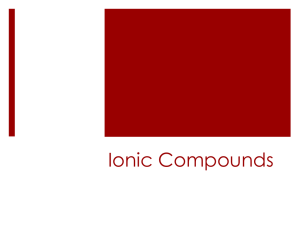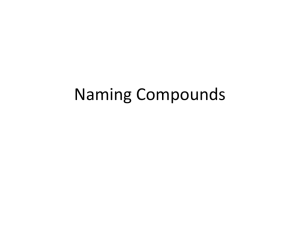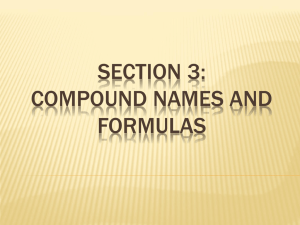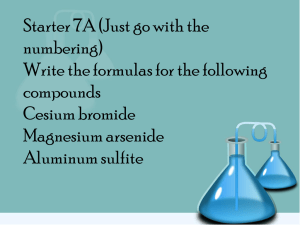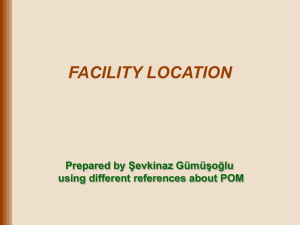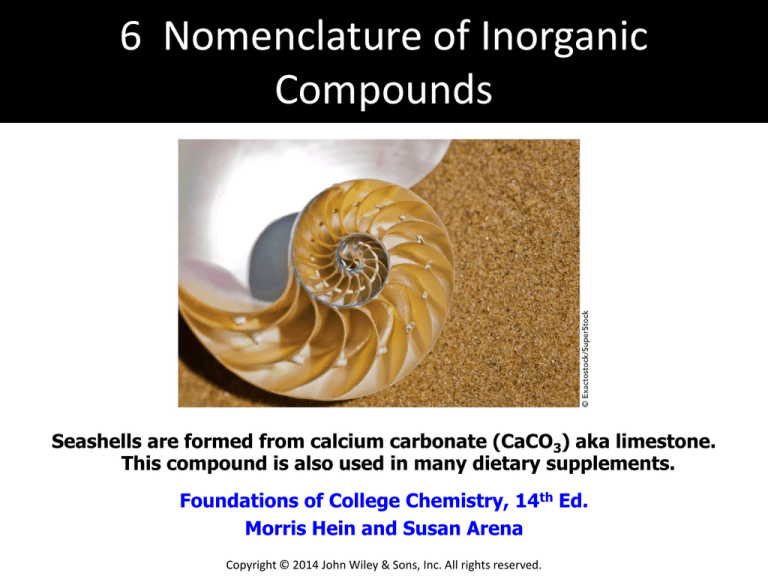
6 Nomenclature of Inorganic
Compounds
Seashells are formed from calcium carbonate (CaCO3) aka limestone.
This compound is also used in many dietary supplements.
Foundations of College Chemistry, 14th Ed.
Morris Hein and Susan Arena
Copyright © 2014 John Wiley & Sons, Inc. All rights reserved.
Chapter Outline
6.1
Common and Systematic Names
6.2
Elements and Ions
6.3
Writing Formulas from Names of Ionic Compounds
6.4
Name Binary Compounds
A. Ionic compounds that contain a metal that forms one
type of cation.
B. Ionic compounds that contain a metal that forms
multiple cations.
C. Binary compounds of two nonmetals.
6.5
Naming Compounds Containing Polyatomic Ions
6.6
Acids
A. Binary acids
© 2014 John Wiley & Sons, Inc. All rights reserved.
Common and Systematic Names
Chemical nomenclature is the systematic naming of
chemical compounds.
Common names are historical names of compounds
which are not based on systematic rules.
Example N2O
Common name: nitrous oxide (laughing gas)
Systematic name: dinitrogen monoxide
Common names reveal nothing about the physical
and chemical properties of a compound.
© 2014 John Wiley & Sons, Inc. All rights reserved.
Common and Systematic Names
Common names are often used because systematic names
are too long and technical for everyday use.
Example CaO
Common name: lime
Systematic name: calcium oxide
Chemists prefer systematic names that precisely identify
the chemical composition of compounds.
The system for nomenclature was devised by the
International Union of Pure and Applied Chemistry.
© 2014 John Wiley & Sons, Inc. All rights reserved.
Naming Flowchart
We will focus on nomenclature of inorganic compounds.
© 2014 John Wiley & Sons, Inc. All rights reserved.
Elements and Ions
The formula for most elements is the symbol
of the element.
Example
sodium (Na)
Exception: certain elements exist as polyatomic
(multiatom) molecules under standard conditions
Example
7 elements exist as diatomic molecules
(contain two atom units)
H2, O2, N2, F2, Cl2, Br2, and I2
Gases
Liquid
Solid
Two other elements exist in polyatomic arrangements
Sulfur - S8
Phosphorus - P4
© 2014 John Wiley & Sons, Inc. All rights reserved.
Elements and Ions
A charged particle, called an ion, can be produced by
adding or removing electrons from a neutral atom.
A neutral potassium atom contains 19 p+ and 19 e-.
A potassium ion can be formed by removing 1 e-.
This gives an ion with 19 p+ and 18 e-, K+.
K
K + + e–
A positive ion is called a cation.
© 2014 John Wiley & Sons, Inc. All rights reserved.
Elements and Ions
Any neutral atom that loses an electron forms a cation.
An atom may lose more than one electron.
Mg
Mg2+ + 2 e-
Al
Al3+ + 3 e-
Cations are named the same as their parent atoms.
K
potassium
K+
potassium ion
Mg
magnesium
Mg2+ magnesium ion
Al
aluminum
Al3+
aluminum ion
© 2014 John Wiley & Sons, Inc. All rights reserved.
Elements and Ions
Any neutral atom that gains an electron forms an anion.
Cl + e–
Cl–
A neutral chlorine atom contains 17 p+ and 17 e–.
A chlorine ion can be formed by adding 1 e–.
This gives an ion with 17 p+ and 18 e-, Cl–.
An atom may also gain more than one electron.
O + 2 e–
O2–
© 2014 John Wiley & Sons, Inc. All rights reserved.
Elements and Ions
Naming Anions
Change the element ending to -ide
Atom
Name
Anion
Name
F
Fluorine
F-
Fluoride ion
Cl
Chlorine
Cl-
Chloride ion
Br
Bromine
Br-
Bromide ion
I
Iodine
I-
Iodide ion
O
Oxygen
O2-
Oxide ion
N
Nitrogen
N3-
Nitride ion
© 2014 John Wiley & Sons, Inc. All rights reserved.
Elements and Ions
Predicting Ion Charge From the Periodic Table
+1
+2
Transition metals:
charges vary
+3
Metals form cations
Charge = Group Number
Group 1A and H: +1
Group 2A : +2
Group 3A (Al): +3
© 2014 John Wiley & Sons, Inc. All rights reserved.
Elements and Ions
Predicting Ion Charge From the Periodic Table
+1
+2
Transition metals:
charges vary
+3
-3 -2 -1
Nonmetals form anions
Charge = 8 - Group Number
Group 5A: -3
Group 6A: -2
Group 7A: -1
© 2014 John Wiley & Sons, Inc. All rights reserved.
Writing Formulas from Names
of Ionic Compounds
Ionic compounds: contain both a cation and an anion.
Example NaCl (table salt)
Ionic compounds must have a net charge of 0.
The sum of the charges of the cations and anions
in an ionic compound equal 0.
Compound
Ions
Least
Common
Multiple
Sum of Charges
Compound
Formula
Sodium bromide
Na+ Br-
1
(1) + (-1) = 0
NaBr
Potassium sulfide
K+ S2-
2
2(1) + (-2) = 0
K2S
Zinc sulfate
Zn2+ SO42-
2
(2) + (-2) = 0
ZnSO4
Ammonium phosphate
NH4+ PO43-
3
3(1) + (-3) = 0
(NH4)3PO4
Aluminum chromate
Al3+ CrO42-
6
2(3) + 3(-2) = 0
Al2(CrO4)3
© 2014 John Wiley & Sons, Inc. All rights reserved.
Writing Formulas from Names
of Ionic Compounds
Rules for Writing Formulas for Ionic Compounds
1. Write the metal ion formula followed by the nonmetal
ion formula.
2. Combine the smallest whole numbers of each ion to
provide an overall charge equal to zero.
3. Write the compound formula for the metal and
nonmetal, using subscripts determined from Step 2
for each ion.
© 2014 John Wiley & Sons, Inc. All rights reserved.
Writing Formulas from Names
of Ionic Compounds
Example
Write the chemical formula for barium nitride.
Step 1: Write the formula for the metal and nonmetal ions.
Ba2+
N3–
Step 2: Determine the number of each ion that will
provide a net charge of 0.
3(Ba2+) + 2(N3–) = 0
3(2+) + 2(3–) = 0
Step 3: Write the correct formula.
Ba3N2
© 2014 John Wiley & Sons, Inc. All rights reserved.
Writing Formulas from Names
of Ionic Compounds
Write the chemical formula for magnesium oxide.
a. MgO
b. Mg2O
c. MgO2
d. Mg2O3
Step 1: Write the formula for the metal and nonmetal ions.
Mg2+
O2–
Step 2: Determine the number of each ion that will
provide a net charge of 0.
(Mg2+) + (N2–) = 0
(2+) + (2–) = 0
Step 3: Write the correct formula.
MgO
© 2014 John Wiley & Sons, Inc. All rights reserved.
Naming Binary Compounds
Binary compounds contain only two different elements.
Binary compounds can be either ionic or molecular.
Ionic binary compounds can be further subdivided:
I) Binary compounds containing a metal which
forms only one cation.
II) Binary compounds containing a metal which
can form multiple cations.
© 2014 John Wiley & Sons, Inc. All rights reserved.
Ionic Binary Compounds
Binary compounds containing a metal which
forms only one cation.
By convention, the cation is written/named first
followed by the anion.
Rules for Naming Binary Ionic Compounds
1. Name the cation.
2. Write the anion root and add the –ide suffix.
Symbol
Element
Root
Anion Name
Br
bromine
brom
bromide
F
fluorine
fluor
fluoride
H
hydrogen
hydr
hydride
N
nitrogen
nitr
nitride
O
oxygen
ox
oxide
© 2014 John Wiley & Sons, Inc. All rights reserved.
Ionic Binary Compounds
Name the compound MgBr2.
1. Name the cation: magnesium.
2. Name the anion : bromide.
The compound is magnesium bromide.
Provide a formula for sodium oxide.
1. Provide the symbol and charge for the cation: Na+.
2. Provide the symbol and charge for the anion: O2-.
3. Charge balance the cation and anion.
Na2O
© 2014 John Wiley & Sons, Inc. All rights reserved.
Writing Formulas for
Ionic Compounds Practice
Name the compound Al2O3.
a. Aluminum(III) oxide
b. Dialuminum trioxide
c. Aluminum oxide
d. Aluminum(III) trioxide
Step 1: Name the cation: aluminum.
(Note Al can only have a +3 charge)
Step 2: Name the anion with an -ide ending.
oxide
Aluminum oxide
© 2014 John Wiley & Sons, Inc. All rights reserved.
Writing Formulas for
Ionic Compounds Practice
Write a chemical formula for calcium sulfide.
a. Ca2S
b. CaS
c. CaS2
d. Ca2S3
Step 1: Provide the symbol for the cation: Ca2+.
Step 2: Provide the symbol for the anion: S2-.
Step 3: Charge balance the compound using subscripts.
© 2014 John Wiley & Sons, Inc. All rights reserved.
Naming Compounds Containing Metals
with Multiple Charges
Transition metals can often form more
than one type of cation.
Example
Cu can exist as either Cu+ or Cu2+
To specify the cation charge in a compound,
a Roman numeral is placed directly after the metal
in the compound name.
Example
iron(III) chloride FeCl3 Fe3+
When a metal forms only one cation (ie Na+),
there is no need to use Roman numerals.
© 2014 John Wiley & Sons, Inc. All rights reserved.
Naming Compounds Containing Metals
with Multiple Charges
Rules for Naming Compounds Involving Metals
that Could Form Multiple Charges
1. Write the cation name.
2. Write the cation charge in Roman numerals in
parentheses.
3. Write the root of the anion and use the –ide suffix.
Exception: for metals that only form two cations, a Latin root
with either an –ous or –ic suffix can also be used.
Formula
Name
Classical Name
Formula
Name
Classical Name
Cu+
Copper(I)
cuprous
Sn2+
Tin(II)
stannous
Cu2+
Copper(II)
cupric
Sn4+
Tin(IV)
stannic
Fe2+
Iron(II)
ferrous
Pb2+
Lead(II)
plumbous
Fe3+
Iron(III)
ferric
Pb4+
Lead(IV)
plumbic
© 2014 John Wiley & Sons, Inc. All rights reserved.
Naming Compounds Containing Metals
with Multiple Charges
Name the compound FeS.
Step 1: Name the cation. Recognize Fe is a transition
metal and can have more than one possible charge.
Step 2: Use the charge of the nonmetal (S2-) to help
choose the Roman numeral and name for Fe.
To charge balance, Fe must be iron(II)
Step 3: Name the anion sulfide
Name:
iron(II) sulfide or ferrous sulfide
© 2014 John Wiley & Sons, Inc. All rights reserved.
Naming Compounds Containing Metals
with Multiple Charges
Name the compound CrCl3.
a. Chromium chloride
b. Chromium(II) chloride
c. Chromium(III) chloride
d. Chromium trichloride
Step 1: Name the cation. Recognize Cr is a transition
metal and can have more than one possible charge.
Step 2: Use the charge of the nonmetal (Cl–) to help
choose the Roman numeral and name for Cr.
To charge balance, Cr must be chromium(III)
Step 3: Name the anion chloride
© 2014 John Wiley & Sons, Inc. All rights reserved.
Naming Compounds Containing Metals
with Multiple Charges
Write a formula for the following compound.
Copper(I) oxide
Step 1: Choose the cation symbol. Recognize Cu is a
transition metal and can have more than one possible
charge.
Step 2: Use the charge of the nonmetal (O2-) to help
choose the number of Cu atoms.
x Cu(+1) + O(2-) = 0
2 Cu atoms are needed to balance the charge.
Name:
Cu2O
© 2014 John Wiley & Sons, Inc. All rights reserved.
Naming Compounds Containing Metals
with Multiple Charges
Write a formula for tin(IV) fluoride.
a. SnF
b. SnF2
c. SnF3
d. SnF4
Step 1: Choose the cation symbol. Recognize Sn can have
more than one possible charge.
Step 2: Use the charge of the nonmetal (F–) to help
choose the number of Sn atoms.
Sn(+4) + x F(–) = 0
4 F atoms are needed to balance the charge.
Name:
SnF4
© 2014 John Wiley & Sons, Inc. All rights reserved.
Binary Compounds Containing
Two Nonmetals
Molecular compounds contain two nonmetals.
Rules for Naming Molecular Compounds
1. Write the name for the first element, including the
appropriate prefix (mono is rarely used).
2. Write the name for the second element, including the
appropriate prefix and -ide ending (mono is used for
the 2nd element).
Prefix
Number
Prefix
Number
mono
1
hexa
6
di
2
hepta
7
tri
3
octa
8
tetra
4
nona
9
penta
5
deca
10
© 2014 John Wiley & Sons, Inc. All rights reserved.
Binary Compounds Containing
Two Nonmetals
Name the following compound.
P2O5
1. diphosphorus indicates 2 P atoms.
2. pentoxide indicates 5 O atoms
Diphosphorus pentoxide
Note: the -o or -a in mono or penta is usually dropped if
there are two vowels next to each other.
Name the following compound.
CCl4
1. chlorine indicates 1 Cl atom (mono not needed).
2. tetrachloride indicates 4 Cl atoms
Carbon tetrachloride
© 2014 John Wiley & Sons, Inc. All rights reserved.
Binary Compounds Containing
Two Nonmetals
Name the following compound.
SO2
a. Sulfur dioxide
1. sulfur indicates 1 S atom.
b. Monosulfur dioxide
2. dioxide indicates 2 O atoms.
c. Sulfur oxide
Sulfur dioxide
d. Sulfur(IV) oxide
Name the following compound.
N2O5
a. Nitrogen oxide
1. dinitrogen indicates 2 N atoms.
b. Dinitrogen oxide
2. pentoxide indicates 5 O atoms.
c. Dinitrogen pentoxide
Dinitrogen pentoxide
d. Nitrogen(V) oxide
© 2014 John Wiley & Sons, Inc. All rights reserved.
Binary Acids
Certain binary compounds containing hydrogen behave as
acids in water and have special names.
HCl(g) is hydrogen chloride
HCl(aq) is hydrochloric acid
Hydrogen is always written first in an acid formula.
(Indicates the compound is an acid versus NH3 or CH4)
Rules for Naming Binary Acids
1. Write the prefix hydro followed by the root of the
second element and add an -ic suffix.
2. Add the word acid.
© 2014 John Wiley & Sons, Inc. All rights reserved.
Binary Acids
Name the following compound.
H 2S
1. hydrosulfuric
2. acid
hydrosulfuric acid
Name the following compound.
HI
1. hydroiodic
2. acid
hydroiodic acid
© 2014 John Wiley & Sons, Inc. All rights reserved.
Binary Acids Practice
Name the following compounds.
H2Se
1. hydroselenic
2. acid
Hydroselenic acid
HF
1. hydrofluoric
2. acid
Hydrofluoric acid
© 2014 John Wiley & Sons, Inc. All rights reserved.
Review of Binary Compound Naming
Binary Compounds
Usually end in -ide
Molecular
(2 Nonmetals)
Use prefixes
to name both
elements
© 2014 John Wiley & Sons, Inc. All rights reserved.
Review of Binary Compound Naming
Binary Compounds
Usually end in -ide
Ionic
(Metal/Nonmetal)
Metal with one
type of cation
1. Name metal
2. Root + -ide
for nonmetal
Metal with
varying cations
(Determine cation charge)
1. Roman numerals
(cation)
2. Root + -ide
for nonmetal
© 2014 John Wiley & Sons, Inc. All rights reserved.
1. Name metal
-ous or -ic suffix
2. Root + -ide
for nonmetal
Review of Binary Compound Naming
Binary Compounds
Usually end in -ide
Hydrogen/Nonmetal
In H2O
Not
in H2O
1. Prefix hydro
suffix -ic
2. Add acid
1. Hydrogen
2. Root + -ide
Suffix for nonmetal
© 2014 John Wiley & Sons, Inc. All rights reserved.
Naming Practice
Name the following compound.
CuCl2
a. Copper chloride
b. Copper(III) chloride
c. Copper(II) chloride
d. Cuprous chloride
1. Cu is a transition metal
2. Based on Cl charge (-1), Cu
must be +2.
Name the following compound.
C3N2
a. Carbon nitride
b. Tricarbon nitride
c. Carbon dinitrogen
d. Tricarbon dinitride
1. tricarbon indicates 3 C atoms.
2. dinitride indicates 2 N atoms.
© 2014 John Wiley & Sons, Inc. All rights reserved.
Naming Practice
Name the following compound.
ICl3
a. Iodine trichloride
1. iodine indicates 1 I atom.
b. Iodochloride
c. Iodine(III) chloride 2. trichloride indicates 3 Cl atoms.
d. Monoiodine trichloride
Name the following compound.
HCl (aq)
a. Hydrogen chloride
b. Hydrochloride
c. Hydrochloric acid
d. Hydrochlorous acid
1. Use the prefix hydro and root
chlor and –ic suffix.
2. Add acid.
© 2014 John Wiley & Sons, Inc. All rights reserved.
Naming Polyatomic Ions
Polyatomic ion: an ion that contains two or more elements.
Example
cyanide anion CN-
Naming compounds containing polyatomic ions is similar
to that for binary compounds.
The cation is named followed by the anion.
The names, formulas, and charges of common
polyatomic ions should be learned.
Rules for Naming Compounds Containing Polyatomic Ions
1. Name the cation.
2. Name the anion.
© 2014 John Wiley & Sons, Inc. All rights reserved.
Common Polyatomic Ions
Name
Formula
Charge
Name
Formula
Charge
Acetate
C2H3O2-
-1
Cyanide
CN-
-1
Ammonium
NH4+
+1
Dichromate
Cr2O72-
-2
Hydrogen
Carbonate
HCO3-
-1
Hydroxide
OH-
-1
Hydrogen
Sulfate
HSO4-
-1
Nitrate
NO3-
-1
Bromate
BrO3-
-1
Nitrite
NO2-
-1
Carbonate
CO32-
-2
Permanganate
MnO4-
-1
Chlorate
ClO3-
-1
Phosphate
PO43-
-3
Chromate
CrO42-
-2
Sulfate
SO42-
-2
Sulfite
SO32-
-2
© 2014 John Wiley & Sons, Inc. All rights reserved.
Oxyanions
Oxyanions: polyatomic ions that contain oxygen
Often end in the suffix -ate or -ite.
-ate compound(s) contains more O atoms
than -ite compound(s).
For elements that form multiple ions with oxygen,
prefixes are also needed.
per: add one oxygen to the -ate root
hypo: subtract one oxygen from the -ite root
© 2014 John Wiley & Sons, Inc. All rights reserved.
Oxyanions
Oxyanions and Oxyacids of Chlorine
Anion Formula
Anion Name
Anion Formula
Anion Name
ClO-
hypochlorite
HClO
hypochlorous acid
ClO2-
chlorite
HClO2
chlorous acid
ClO3-
chlorate
HClO3
chloric acid
ClO4-
perchlorate
HClO4
perchloric acid
© 2014 John Wiley & Sons, Inc. All rights reserved.
Naming Polyatomic Ions Practice
Name the following compound.
NaNO3
a. Sodium nitrogen trioxide
b. Sodium nitrite
c. Sodium nitrate
d. Sodium pernitrate
Name the following compound.
KCN
a. Potassium monocarbon monoxide
b. Potassium(I) cyanide
c. Potassium monocyanide
d. Potassium cyanide
© 2014 John Wiley & Sons, Inc. All rights reserved.
Naming Polyatomic Ions Practice
Name the following compound.
LiClO2
a. Lithium chlorite
b. Lithium perchlorate
c. Lithium hypochlorite
d. Lithium chlorate
Name the following compound.
NH4I
a. Ammonia iodide
b. Ammonium iodide
c. Ammonium(I) iodide
d. Ammonium monoiodide
© 2014 John Wiley & Sons, Inc. All rights reserved.
More Complicated Polyatomics
Inorganic ions can be formed from more than 3 elements.
The same method is used as before:
identify the ions and name in order -- cations then anions.
Compound
Ions
Name
NaHCO3
Na+; HCO3-
Sodium hydrogen carbonate
NaHS
Na+; HS-
Sodium hydrogen sulfide
MgNH4PO4
Mg2+; NH4+; PO43-
Magnesium ammonium phosphate
NaKSO4
Na+; K+; SO42-
Sodium potassium sulfate
© 2014 John Wiley & Sons, Inc. All rights reserved.
Complicated Polyatomic Ions Practice
Name the following compound.
KAl(SO4)2
a. Potassium aluminum sulfate
b. Potassium aluminum sulfite
c. Potassium aluminum(III) sulfate
d. Potassium aluminum disulfate
Name the following compound.
Ca(HSO3)2
a. Calcium hydrogen sulfate
b. Calcium hydrogen sulfite
c. Calcium hydrogen persulfate
d. Calcium hydrogen hyposulfite
© 2014 John Wiley & Sons, Inc. All rights reserved.
Naming Acids
Acids often begin with hydrogen.
To recognize oxyacids, make sure:
1. H is the first element in the formula.
2. The compound contains a polyatomic ion with oxygen.
The following modifications are made to
the name of an acid:
–ate ions are changed to –ic acids
–ite ions are changed to –ous acids
–ic acids contain one more oxygen than –ous acids
© 2014 John Wiley & Sons, Inc. All rights reserved.
Naming Acids Practice
Name the following acid.
H2SO4
a. Dihydrogen sulfate
Derived from sulfate anion.
b. Sulfurous acid
Change to –ic ending.
c. Sulfuric acid
Acid added to show the presence of H.
d. Persulfuric acid
Name the following acid.
HNO2
a. Nitrous acid
b. Nitric acid
c. Hydrogen nitrite
d. Hydrogen nitrate
Derived from the nitrite anion.
Change to –ous ending.
Acid added to show the presence of H.
© 2014 John Wiley & Sons, Inc. All rights reserved.
Naming Acids Flowchart
Acid (begins with H)
Anion contains
Oxygen
Anion does not
contain oxygen
Check ending on
anion
1. Use prefix hydro and suffix -ic
2. Add word acid
-ite
Change to -ous acid
-ate
Change to -ic acid
© 2014 John Wiley & Sons, Inc. All rights reserved.
Learning Objectives
6.1 Common and Systematic Names
Distinguish between the common and systematic names
of chemical substances.
6.2 Elements and Ions
Discuss the formation, charge, and naming of simple ions.
6.3 Writing Formulas from Names of Ionic Compounds
Write the chemical formula for an ionic compound
from the name of the compound.
© 2014 John Wiley & Sons, Inc. All rights reserved.
Learning Objectives
6.4 Naming Binary Compounds
Name binary ionic and molecular compounds.
6.5 Acids
Use the rules to name an acid from its formula and to
write the formula of an acid from its name.
© 2014 John Wiley & Sons, Inc. All rights reserved.


